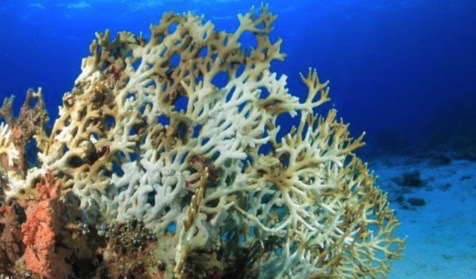The Grim Reality of Earth’s Oceans

JARED SOLOVEI – Climate change continues to be one of the most over-simplified scientific concepts in the public forum. What in reality is the unimaginably complex interaction between a myriad of biotic and abiotic factors is often reduced to “the Earth is getting warmer”. And while it is certainly true that average global temperatures are on the rise, the effects of our short sighted mishandling of Earth’s resources are innumerable. Our planet is a fragile, multi-faceted system, which over billions of years has achieved a delicate balance. This balance provides ideal conditions for life on Earth, and when disrupted can have severe consequences.
The burning of biological matter in the form of fossil fuels along with the resulting release of carbon dioxide (CO₂) into the atmosphere poses an immense threat to all life on Earth. Increased CO₂ emissions disrupts nature in several ways, one of which is significantly altering the alkaline nature of marine ecosystems through a process known as ocean acidification. This phenomenon can result in decreased biodiversity and conditions that are hostile to aquatic life.
An acid is often defined as a substance that increases the concentration of hydrogen ions in a solution. Acidity is measured in terms of pH which places hydrogen ion concentration on a scale from 0 (highly acidic) to 14 (highly basic). Ocean acidification is directly linked to CO₂ emissions by virtue of basic chemistry. As more CO₂ is released into the atmosphere, some of it is dissolved into the ocean. The CO₂ combines with water to form carbonic acid. Carbonic acid then releases hydrogen ions and subsequently lowers pH. Since the industrial revolution, ocean pH has decreased from approximately 8.2 to 8.1. This doesn’t seem like a big deal until you consider the fact that pH exists on a logarithmic scale. This means that a pH of 1 is ten times more acidic than a pH of 2. Therefore, this decrease of 0.1 actually represents a 25% increase in ocean acidity.
Now that we understand what acidity is and how CO₂ causes it to increase, we can investigate its impact on the world around us. As of 2015, ocean acidification had cost the Oyster industry over 100 million dollars. To understand why, we’ll need another brief chemistry lesson. Oyster shells are primarily composed of calcium carbonate (CaCO₃), which itself is comprised of a calcium ion (Ca2+) and a carbonate ion (CO32-). Under normal circumstances, there is plenty of calcium carbonate to go around, and oysters are free to build shells. However, if we introduce a little acidity, things change. An acid (like carbonic acid) increases the hydrogen ion concentration in a solution. And just like the calcium ion, hydrogen ions like to bond to carbonate ions. The more hydrogen ions bond to carbonate ions, less carbonate is available to make the calcium carbonate that oysters so desperately need. This makes it more difficult for oysters to build their shells and can even cause them to dissolve.
This problem does not stop at oysters. There is a long list of organisms that rely on the calcium carbonate shell/skeleton to survive. Starfish, sea urchins, scallops, mussels, and pteropods are just some examples of calcifying organisms that rely on calcium carbonate. Even more alarming, the rocky structures that make up coral reefs are made entirely of CaCO₃. Only the surface of coral reefs contain the living coral polyps, the rest is a calcium carbonate skeleton that becomes increasingly difficult to form as ocean pH drops. This matters, because despite coral reefs making up less than 1% of the ocean floor, they facilitate the life cycles of more than a quarter of all marine species. The disappearance of coral reefs could spell disaster for life on Earth, and this nightmare will be realized if the rate of coral formation is reduced to the point that it can no longer keep up with erosional processes.
To continue to take a lackadaisical approach when it comes to climate change and ocean acidification would be a grave mistake. The disruption of our fragile biosphere will fundamentally change living conditions for countless organisms.These changes will not remain isolated to marine ecosystems and have the potential to be planet-altering. Refusal to drastically cut CO₂ emissions by switching to readily available renewable fuel sources will inevitably lead to unforeseeable repercussions that will severely alter our planet.
Copy Editor: Annie Patel
Photography Source: https://www.iucn.org/theme/marine-and-polar/our-work/climate-change-and-ocean/ocean-acidification
